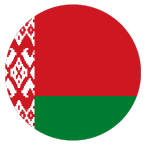According to Ethnologue, there are around 7.8 million Belarusian speakers around the world.
Where is Belarusian Spoken?
Belarusian is one of the official languages of Belarus, alongside Russian. It is also spoken in other countries around the world such as Russia, other former republics of the Soviet Union, and the U.S., Canada, and Australia.

FACT
According to UNESCO classification, Belarusian may be on the verge of extinction and is considered an endangered language.
Did you Know?
Belarusian is considered one of the most melodic languages, second after Italian!
Belarusian Dialects
- Northeastern
- Southwestern
- Central on which Standard Belarusian is based.
4 Easy Phrases in Belarusian!
| Belarusian | English |
|---|---|
| Добрый день (Dobry dzien) | Hello |
| Прыемна пазнаёміцца (Da pa-bach-jennja) | Goodbye |
| Дзякуй (Dziakuj) | Thank you |
| Як справы? (Yuk spraavey) | How are you? |
Population vs. Internet Penetration
Belarus Population:
9,449,323
Internet Users:
7,521,628
Penetration:
79.6%
As of 2020. Source:
www.internetworldstats.com
FACT!
Belarusian is a Slavic language that is a close relative of Russian and Polish. Ukrainian is another close relative, sharing 84% of common vocabulary. In fact, Belarusians can easily understand Ukrainian!
Belarusian, Russian, Ukrainian & Polish Words!
| English | Belarusian | Russian | Ukrainian | Polish |
|---|---|---|---|---|
| hello | pryvitanne | privet | pryvit | cześć |
| goodbye | da pabačennia | do svidaniya | do pobachennya | do widzenia |
| please | kali laska | pozhaluysta | bud’ laska | proszę |
| potato | bul’ba | kartoshka | kartoplya | ziemniak |
Source: hifivebelarus.com
Belarusian Translation Tips
- Belarusian has three genders: masculine, feminine and neuter.
- It has three cases of numbers: singular and plural and sometimes dual.
- Belarusian has no indefinite or definite articles.
- The neutral word order in Belarusian is Subject-Verb-Object, however other orders are possible.
- Verbs in Belarusian have two tenses: past and non-past. The present and future tenses have the same endings.
Are you looking for professional Belarusian translation services? Get in touch with Pangea Global! We’ll hook you up with one of our professional linguists who will provide you with accurate and reliable Belarusian localization services, copywriting, voice overs and more!






